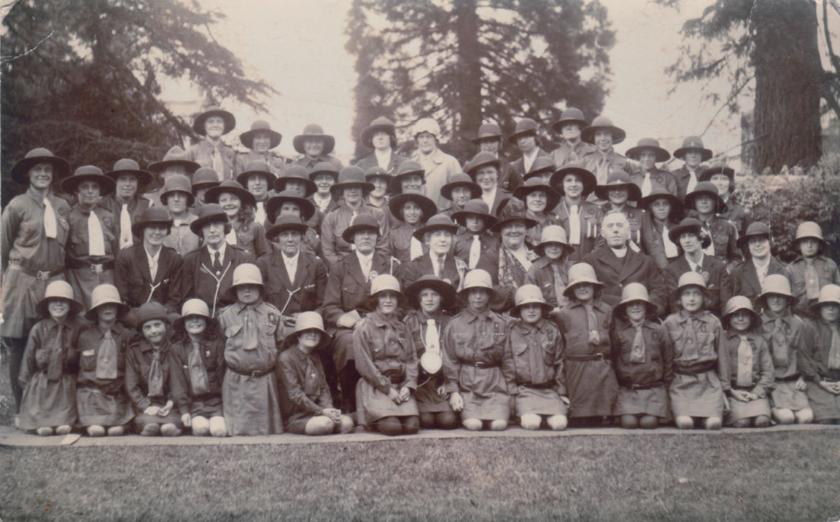

* You can search the website from the Home Page *
* Quarries and mines *
Ashburton as a stannary town
See also Local administration, under Gathering together.
A stannary town is a town where refined tin was checked for quality, weighed, stamped and assessed for the payment of duty.
Circa 1310* the tin-miners,(stannary men) of Devon petitioned the King for a Tuesday market and a twice-yearly fair at Chagford. They said that the late king had granted them 'many liberties' in Devon, and that they were 'assigned to live in three vills, namely Tavistock, Ashburton and Chagford.' The Chagford men complained that although they still held their courts and pleas in the town there was no market or fair where food, drink and other necessities could be purchased.
The council considered that the request should not be granted because of the damage to neighbouring markets and fairs of the Bishop of Exeter and Hugh de Courtenay.
*A note says that the dating of this petition is unsatisfactory, and may be from considerably later.
National Archives ref SC 8/42/2098 See below for more on references to records
Available to view for free from http://discovery.nationalarchives.gov.uk - Accessed 4-1-2014
*******
http://discovery.nationalarchives.gov.uk - Accessed 5-1-2014
This document can be downloaded for free.
*******
http://discovery.nationalarchives.gov.uk/ Accessed 5-1-2014 This document can be downloaded for free.
*******
Circa 1533 - 1538 John Wynter took Thomas Revell to court over the forgery of a grant of land and pasture called Tynwork in Ashburton, Devon.
National Archives C 1/923/73-76
http://discovery.nationalarchives.gov.uk - Accessed 7-1-2014
*******
Circa 1538-44 brothers Christopher and Thomas Denbowe were in dispute over a tenement in London, bequeathed to them by their father Christopher. The price of the tenement was partly determined by the sale of goods and a tinwork in Ashburton
National Archives C 1/980/34
http://discovery.nationalarchives.gov.uk - Accessed 7-1-2014
All records coded SC come from various departments, and were formerly entitled Special Collection
All records coded C are records created, acquired and inherited by Chancery, or are of the Wardrobe, Royal Household, Exchequer and various commissions.*******
1547-48 George Wyndeate was paid 2s for riding to Exeter for 'le tynn wyghtes.'
Churchwardens' Accounts of Ashburton 1479-1580, Alison Hanham, Devon and Cornwall Record Society, printed Devonshire Press 1970, p121
*******
1563
A letter of attorney kept in the Plymouth and West Devon Record Office
involves Richard Luscombe of Ashburton, a groom, and Richard Harell. It
concerns a tinwork in Lemmenforde Combe, Ashburton stannery.
http://discovery.nationalarchives.gov.uk, ref 372/3/1/4
*******
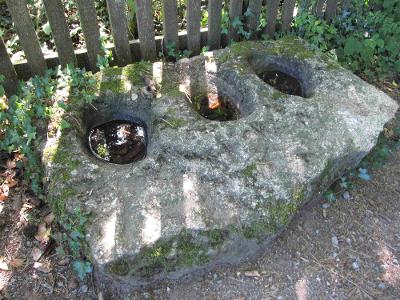
At one of the meetings of the Field Club, the group observed ancient tin workings at Waterleaf* Bridge.
Western Times 26 May 1922 p10 col1
* This surely must be Waterleat Bridge
'At
the present time (1831) the state of mining in this county is at a low
ebb. Various copper lodes have been tried since the period to which the
preceding accounts relate; and though ore has been found in many, the
quantity has not often been sufficient to pay for the working of them.'
The history of Devonshire, the Rev. Thomas Moore, undated, p529
Peter Coade of Kay, Cornwall, who had lived in Ashburton for about 30 years, died at Rose Cottage, Ashburton in February 1845. He had been Captain of various tin and copper mines in the district, and those who worked for him found him to be 'a kind master and a benevolent friend.' A Wesleyan and supporter of Reform, he was well respected. Mr Coade was 69.
Western Times 8 February 1845, p3 col1
The
only quarrying or mining activities specifically labelled on the 1840
tithe map of Ashburton are tin mines near Owlicombe. The Rev. Thomas
Moore, above, says that the Owlacombe mines were abandoned circa 1815; however, as the items below show, there was obviously activity there later on.
Western Times 9 November 1848 p5 col2
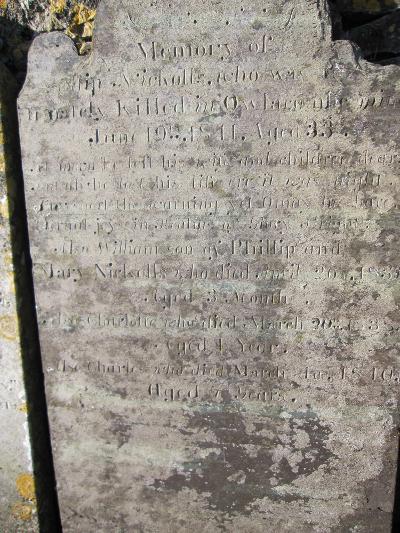
In 1851 steam machinery was being installed at the West Beam and Owlacombe tin mines.
There was optimism of returns from Old Brimpts Tin Mine and South Plain Wood. A shaft was still being sunk at South Plain, but some 'fine specimens' of copper had been found.
Western Times 24 May 1851 p7 col2
The machinery included four water wheels, the largest 40 foot in diameter.
Exeter Flying Post 18 March 1852 p1 col2
A lode of tin was allegedly discovered on the Druid Estate in 1851.
Western Times 24 May 1851 p7 col2
In 1852 John Sparke Amery of Druid, Ashburton,
James Whitton Arundell of 11 Chancery Lane, Middlesex, William Williams
of Buckfastleigh, (mining agent ) and Edward Preston Walker of
Arlington Street, Middlesex, entered into a 7 year lease 'To search for
ores, metals and minerals in Druid and Rew Down'
The documents, ref 2180/7 1852, are held at the Plymouth and West Devon Record Office.
May
1852 The Wheal Arundel Mine was opened on the Druid Estate, belonging
to John Sparke Amery. Capt Williams was the superintendent.
Western Times 8 May 1852 p7 col3
A prospectus for the Arundel Copper mine (sold privately, not in my possession) stated that there were three separate mining setts, held from the freeholder John Sparke Amery, for a period of 24 years. 10,000
shares of £1 each were offered. The prospectus, date unknown, included
six reports by committee members: Joseph John William Watson, William
Williams, Captain James Carpenter, and Captain Michael Stephens.
A statement in the Exeter and Plymouth Gazette duplicates many of the above details. The 'richness of the ores' and 'abundance of the lodes' meant that expensive machinery would not be necessary to extract the minerals.
Johnson and Matthey, 29, Hatton Garden, London, allegedly assayed a sample and found 8½% pure copper.
Exeter and Plymouth Gazette 10 July 1852 p2 col4
The lode at the Wheal Arundel Mine, 'on the Druid Estate' was said to be 'most promising.'
Western Times 2 October 1852 p7 col5
Later that month the proprietors of the Wheal Arundel mines established a fund to provide for workers who were ill or who had been involved in accidents. The Western Times believed it to be the first in the country. And in 1853 the Exeter and Plymouth Gazette praised the same company for distributing wood and coal to its workforce.
Western Times 30 October 1852 p7 col3
Exeter and Plymouth Gazette 5 March 1853 p4 col2
In May of the same year Mr. Josiah Hitchens had prepared a very favourable report on the mine. Confident
that it would be profitable, he encouraged the installation of a steam
engine and the sinking of a substantial shaft. Having become a
shareholder, Mr. Hitchens asked for the remuneration for his services to
take the form of 'an interest in the dividend development'. Although
there had been considerable expenditure in the mine, the company was
still £3754 8s 5d in credit. The miners had been provided with a
library.
London Daily News 27 May 1853, p6 cols3,4
Mine no. 39, Devon Great Huel Ellen, Copper and tin, Ashburton, purser or secretary Thos. Showell, suspended. Mine no. 42, Devon New Copper, P., Copper, Ashburton, purser or secretary J Sparke Avery, suspended. Memoirs of the Geological Survey of Great Brtain....Mineral Statistics for year 1864, Robert Hunt, HMSO, London, 1865, p245
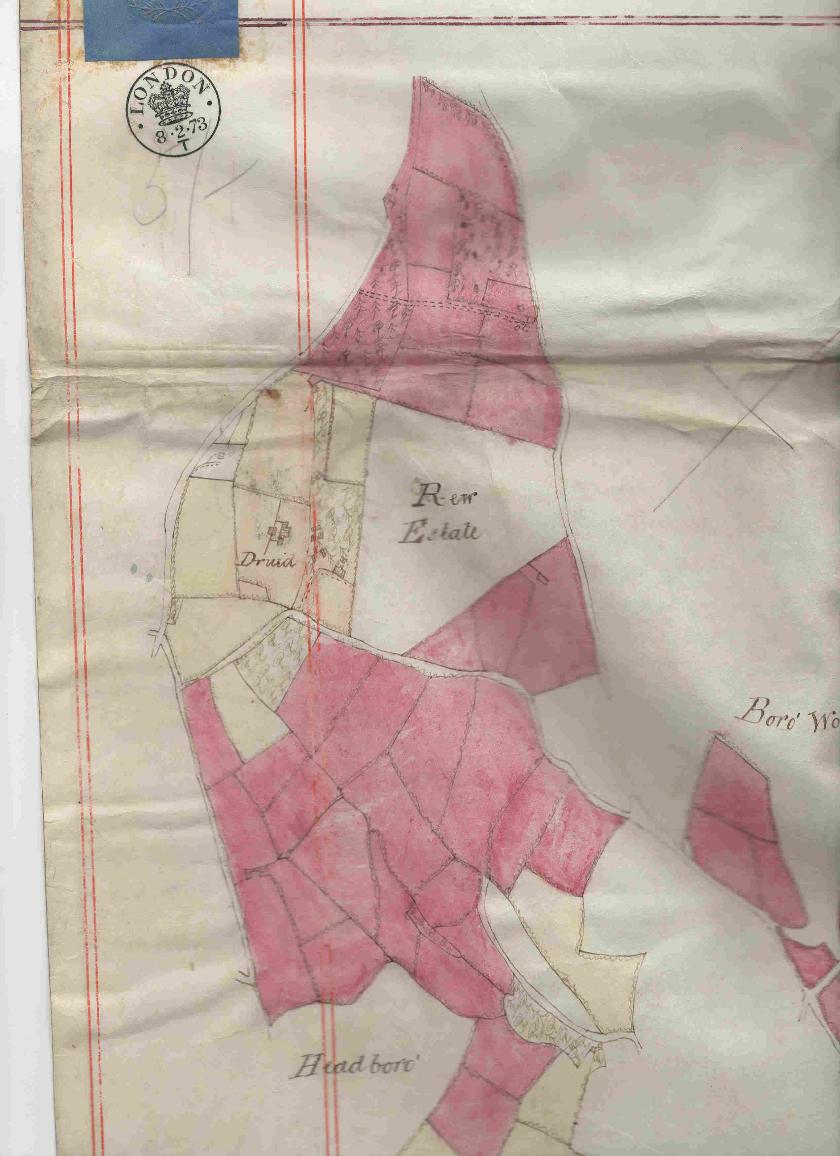
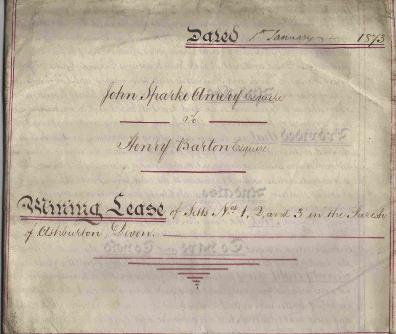
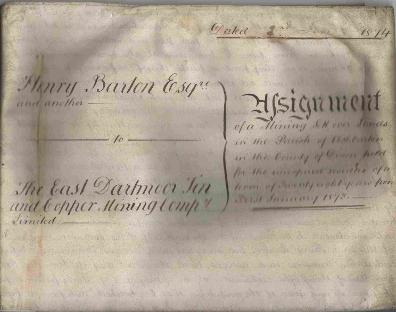
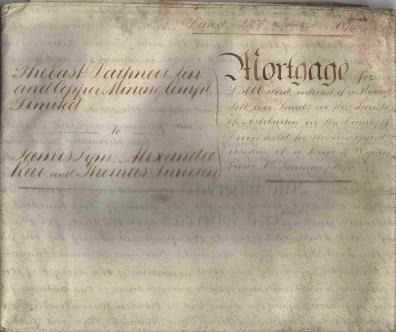
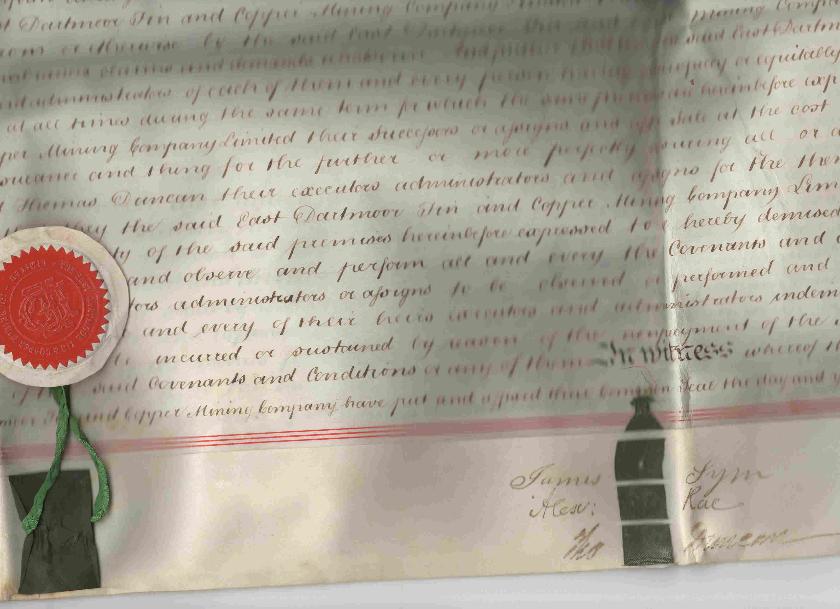
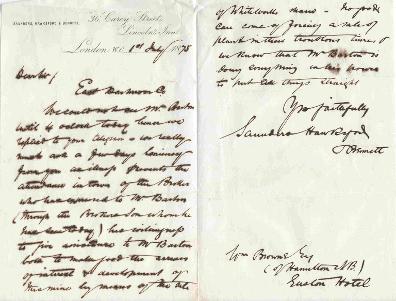
Items from the London Gazette plus additional sources
Joint Stock Companies.
Under a Companies Act of 1880, certain companies were given notice that they would be dissolved after 3 months and struck off the register, unless they could prove that this should not be the case
The following companies were named in connection with this Act - they may not be connected with the town:
East Ashburton United Tin and Copper Mining Company Ltd
London Gazette Issue 25040 22 November 1881, p5724
The company was struck off in the following March
Ashburton Tin and Copper Mining Company Ltd
London Gazette Issue 25241 12 June 1883, p3040
The company was struck off in the following September
See Druid Mine, right
Ashburton Tin and Copper Mining Company Ltd. Truro Registry Company No 203. Incorporated 1872, dissolved by 1914
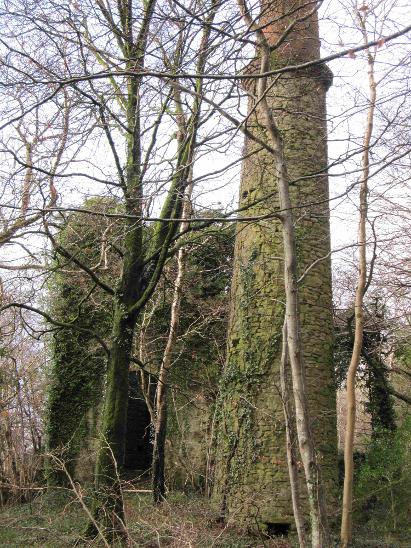
Above and below: Druid Mine, known by a variety of names at different times, including the Ashburton Tin and Copper Mining Company Ltd.
My own photographs 2012
For a detailed description of the mine, plus drawings, see A Survey of Engine Houses on the Mines of South Devon, Richard W M Nance and R Damian Nance, The Bulletin of the Peak District Mines Historical Society, Vol 13, No 2, p 114ff.
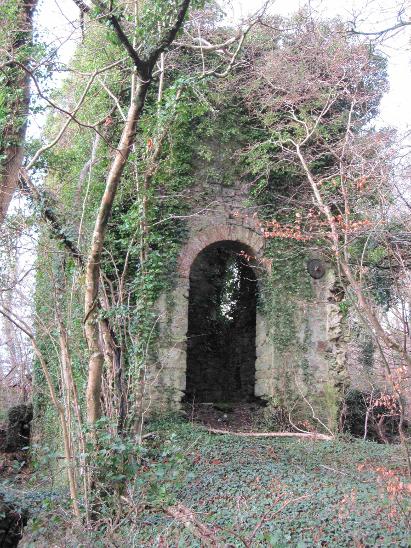
Western Times 26 March 1914 p3 col7
See also A Vignette on Druid Mine in Devon, publ. Northern Mine Research Society, Sheffield, 1995 www.nmrs.org.uk/publications/pdf/BM55/BM55-90-93-druid.pdf - Accessed 22-2-2016
*******
South Plain Wood (Ashburton), copper; purser - J Nicholson; offices, 90, New Bond Street. The Mining Guide, publ. at the office of The Mining Journal, London, 1853, p54
There was concern in 1853 about the spiritual needs of the influx of miners to the Ashburton area, who were, said the Exeter and Plymouth Gazette, 'scattered on the hills like sheep which have no shepherd'. The owners of the Devon Tin Mines had built an iron-house at Dartmeet, which could accommodate 100 people for worship, but the Church was proving inflexible at organizing services by 'missionary' chaplains.
Exeter and Plymouth Gazette 17 December 1853 p4 col2
There
was almost full employment in the Ashburton area in 1855 - the
industries quoted were the mines, the woollen industry, and the Penn
Recca slate quarries*.
*In Staverton parish
1860. A meeting of miners and working men was called
with the aim of improving their social and mental well-being. The
Chairman asked, 'Where was the Mechanics' Institute? Where was the
museum? Where was the free library?' None of these institutions existed.
Exeter and Plymouth Gazette 30 November 1860 p7 col3
1861 A fall of earth buried two boys, both named Cox, whilst they were working in the Ashburton United Mine. They were quickly dug out, but one died of his injuries.
Western Times 21 December 1861 p3 col3
'Gross swindling may be perpetrated under the form of mine speculation.'
Western Times 13 April 1861 p5 col3
When
E Wadge* married Mary Ann Mortimore at the Independent Chapel in March
1861, he was described as 'clerk to the Ashburton United Mines'.
Western Times 23 March 1861 p5 col5
*Edwin Harvey Wadge and Mary Ann Harriet Mortimore www.freebmd.org.uk
In April 1861 a case was heard at Exeter County
Court where William Richards, captain of the West Ashburton Mine, was
claiming £10 10s wages from Charles Wescomb, as one of the shareholders.
The defence was that Mr Wescomb was merely acting as an agent.
The
mine was started by William Richards and Capt. Philip Hawke in 1859
under the name of the East Hazel Mine, and Mr Erwin H Wadge had
subsequently become involved. Mr Wadge was now articled to a solicitor
in Teignmouth, but had then been living in Ashburton. A gentlemen's
servant became the fourth shareholder. In March 1860 Mr Wadge had
transferred all his shares to a new shareholder and resigned from the
partnership. The new shareholder had the books examined, and Mr Wadge
was called upon to correct errors and omissions before a meeting to be
held in July 1860. Instead Mr Wadge and others, including his brother
Edwin Wadge, seized the books and carried them off. The case, which was
adjourned, got more complicated, not least because the name of the
mine was changed from East Hazel to West Ashburton.
Exeter and Plymouth Gazette 12 April 1861 p10 col3
The
Western Times was forthright in its analysis. Stating that 'fine copper
lodes' had allegedly been indicated, it suspected 'gross swindling' (see quote above). The paper warned that people who tried to get rich quickly might keep their innocence, but not their money.
1865 'A brace' of miners, Johns and Kingdom, were remanded on bail. Johns, whilst drunk, had assaulted Constable Balsdon; Kingdom had then become involved, and he was charged with unlawful interference. Western Times 5 May 1865 p7 col2
*******
'Buried
Alive.' In 1867 an abandoned mine shaft was being filled in near
Ashburton. Mr Andrews, a farmer, was standing within forty feet of the
shaft when the ground collapsed, completely burying him. It was several
hours before men were able to dig the body out, which was 'standing
erect'.
Exeter and Plymouth Gazette 16 August 1867 p7 col2
*******
In 1870 the returns of copper ore from the Brook Wood Mine were encouraging
Western Times 6 June 1870 p2 col5*******
1873
Three miners from Ashburton, James Pearce, Joshua Leaman and William
Bramwell, were summoned for not paying a labourer whom they had
sub-contracted to work for them at Town Wood Mine, Ilsington. They were
ordered to pay the full amount of 12s wages, plus £1 5s 3d costs.
Exeter and Plymouth Gazette 25 February 1873 p4 col1
*******
Partnership dissolved between William W Mansell, Geo. Peverall and Wm Stansfield, working the Bowdon Hill Mine in the parish of Ashburton
London Gazette Issue 23936 10 January 1873, p92
*******
'The population of Ashburton has declined steadily since 1861, in consequence of the decrease of mining operations'.White's History, Gazetteer & Directory of Devon, 1878-79, p82
*******
'The copper and tin mines are not worked at present.'
Kelly's Directory of Devonshire 1889 p24
*******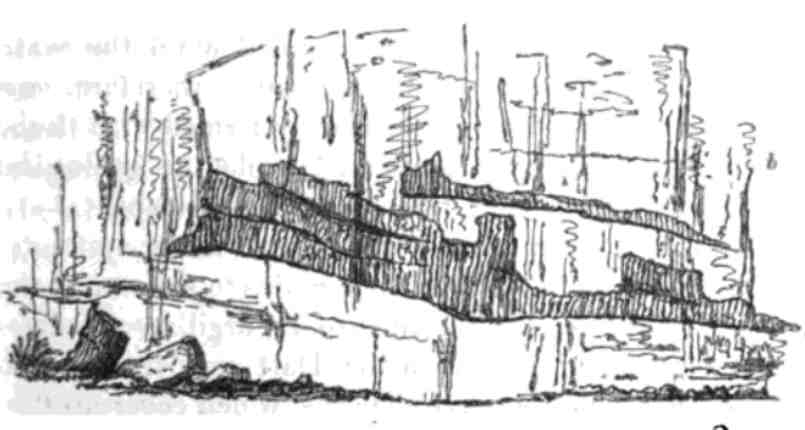
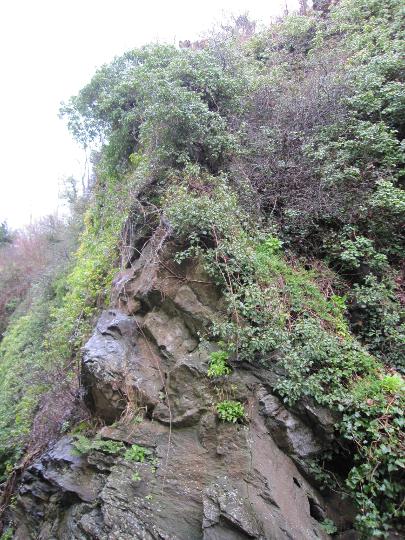
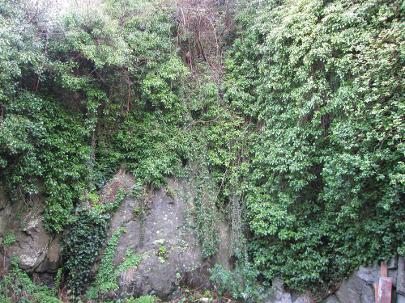
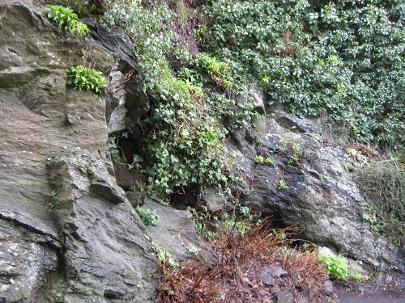
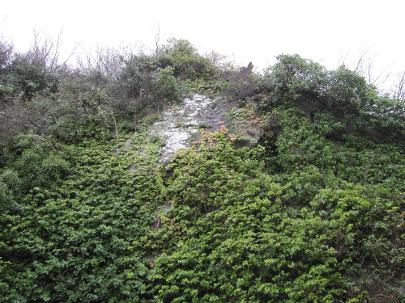
*******
Petition for the winding up of the Ashburton Slate Quarries Ltd
London Gazette Issue 25254 27 July 1883, p3784
*******
Joint Stock Companies.
Ashburton Slate Quarries Ltd given notice that they would be dissolved after 3 months and struck off the register, unless they could prove that this should not be the case
London Gazette Issue 26004 20 December 1889, p7363
The company was struck off in the following March
Company No: 17452; Ashburton Slate Quarries Ltd. Incorporated in 1882. Dissolved before 1916
*******
In 1852 the Western Times reported that some large blocks of marble had been excavated from quarries adjoining the town. A suggested use was for chimney pieces, 'the veins and colour......are considered superior to any quarry in the South of Devon.'
Western Times 31 July 1852, p5 col5
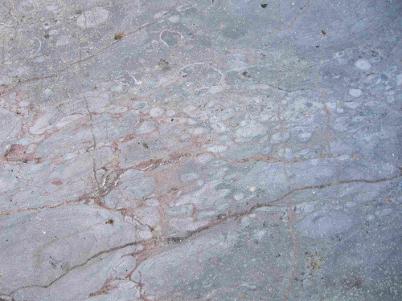
Above: Sample of what is believed to be unpolished Ashburton marble.
Below: Plaque outside the Information Office, made from Ashburton marble.
My own photographs 2013 and 2014
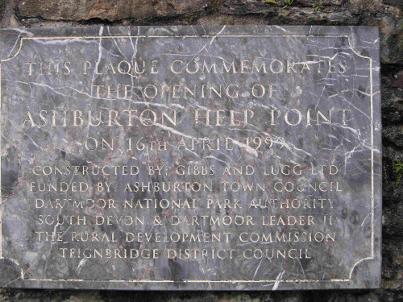
3 Brass plaques in the Tower Base of St Andrew's Church are mounted on Ashburton marble.
The steps in the Chancel, Sanctuary and Lady Chapel are all of Ashburton marble.
St Andrew's Church, Ashburton - A guide and short history, publ. St Andrew's Church 5th edition 2005/06
Right: Step in the Chancel, St. Andrew's Church.
My own photograph 2014
Ashburton marble was quarried from the Linhay Quarry at the eastern end of the town until the late 20th century.
In fact it is not a true marble: to be called this it would have had to have undergone extremes of heat which did not occur with this limestone. But the lower temperatures and pressure did preserve many of the fossil corals, and resulted in a grey/black stone, capable of taking a high polish, with beautiful patterns of white calcite and red haematite.
Devonian limestones, David Allen
http://www.devon.gov.uk/geo-devonianlimestone.pdf - Accessed 09-02-2014
It is allegedly in the bathrooms of the London Hilton and the Post Office Tower, also in the President Roosevelt Memorial in Washington DC.
http://www.britannicus-stone.co.uk - Accessed 09-02-2014
Ashurst and Dimes say that in the US Ashburton marble is known as Renfrew marble.
Conservation of building and decorative stone, John Ashurst and Francis G Dimes, Routledge, Oxford and New York, 2011, p90
In Hull, the East Yorkshire RIGS Group designated the following as one of the Regionally Important Geological and Geomorphological Sites:
Williamson's Solicitors in Lowegate, which has polished slabs of Ashburton marble on its frontage.
www.hull.ac.uk/php/chsmjh/urbrigs.htm - Accessed 09-02-2014
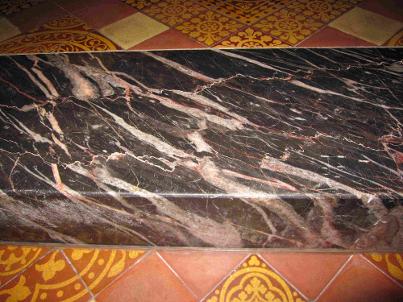
A tablet made of local marble by T W Mann was erected in the Wesleyan Chapel in memory of Rebecca Michelmore. She left '£1000 in Consols', the interest of which was to be used for charitable purposes.
Exeter and Plymouth Gazette 24 December 1886 p3 col6
In 1897 Mr Fabyan Amery gave a talk entitled 'A piece of Ashburton marble.' In it he spoke of marble quarrying by Messrs Blacker at Stawell Bushes
Western Times 4 May 1897, p9 col7
A font at East Allington church was dedicated in December 1899 to the memory of the Rev. H R Fortescue. The base and approaching foot base were made of Ashburton Marble, 'richly veined and highly polished'.
Western Times 12 December 1899 p3 col5
In
1934 the King opened the new building of the Royal Institute of British
Architects. Four steel stanchions at the sides of the stairwell were
encased with Ashburton marble, mainly black with dull red veins. The
architect, Mr George Grey Wornum, had chosen Ashburton marble because of
the richness of its colour, and because he only wanted to use materials
from within the Empire.
Western Morning News 9 November 1934 p8 col4
*******
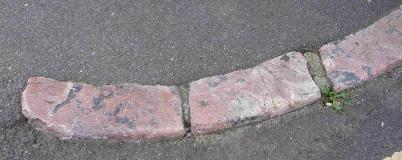
My own photograph, 2013
Many
of Ashburton's kerbstones were believed to be made of Ashburton marble,
but Professor Gordon Walkden, who has extensively researched Devonshire
marbles, says 'There is no evidence in Linhay now, or at any time, of
the light-grey to pink reef rock seen along the streets of the town.' He
believes Ashburton's kerbstones to come from Stoneycombe Quarry near
Newton Abbot - the stone would have been easily transported by rail,
Stoneycombe's favoured means of transport.
Devonshire
Marbles: their geology, history and uses, Gordon Walkden, Geologists'
Association Guide No.72, 2015, in 2 vols., p 299.
In 1930 Stawell's Bush quarry plus fields, including a marble quarry, which were part of the Firth Estate, sold for £305 to Messrs H T Jenkins and Son Ltd., Torquay.
Western Times 25 July 1930, p14 col1
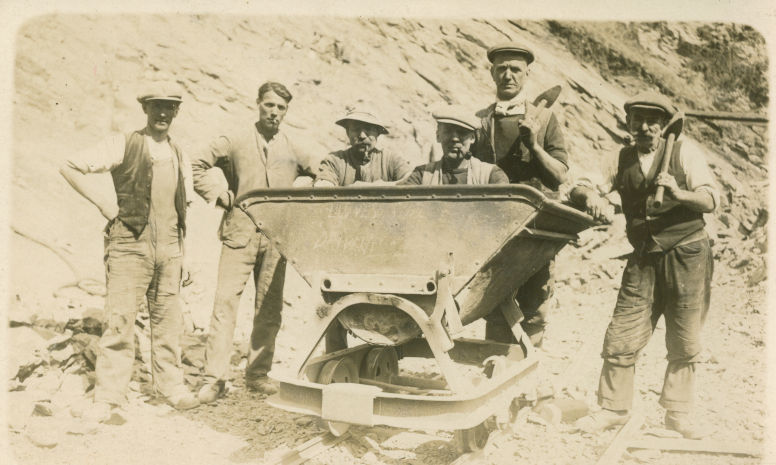
True umber, a form of haematite containing manganese, is rare in Britain, but has been found in Devon and Cornwall, as well as the Isle of Man. It was used for paint, for making brown paper, and, according to John Satterly, in sheep-dipping powders.
Devon's Rocks, a Geological Guide
www.devon.gov.uk/geo-devonroacksgeologyguide.pdf
http://www.coloracademy.co.uk/
Memories of Ashburton in Late Victorian Days, John Satterly,Transactions of the Devonshire Association 1952 vol 84 p34
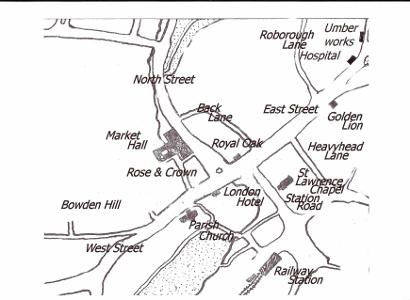
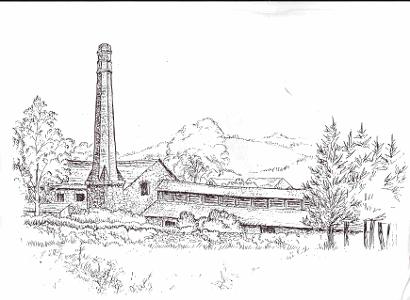
Above: Old umber processing works, near the railway station. John Satterly's memories of the water supply near Stone Park suggest that this may have been the Truro Company's paint works.
Memories of Ashburton in Late Victorian Days, John Satterly 1952 vol 84 Transactions of the Devonshire Association p34
Drawing courtesy of the Wakeham family.
Left: A map (based on a map drawn in the 1950s) showing the umber works in the top right hand corner. Not to scale.
Umber working was not confined to the eastern end of the town.
Whilst sinking a shaft at the end of West Street, in search of iron, a 'fine bed of umber' was discovered.
Western Times 9 August 1872 p7 col3
Partnership dissolved between William W Mansell, Geo. Peverall and Wm Stansfield, working the Bowdon Hill Mine in the parish of Ashburton
London Gazette Issue 23936 10 January 1873, p92
John Satterly talks of umber working at both ends of the town.
Memories of Ashburton in Late Victorian Days, John Satterly, Transactions of the Devonshire Association, 1952 vol 84 p34
The shape of umber pits can still be seen in a field off Bowden Hill (on private land). On the 'Britain from Above' website http://www.britainfromabove.org.uk/ the site can be seen in the bottom left hand corner of the image entitled 'The town and railway station, Ashburton, 1930'
*******
In 1869 it was reported that the umber now being extracted at the Umber Works was of a much better quality, and that the deposit stretched over a 'great many acres to the east of the town'. In December of the following year 200 tons of umber were being carted to the railway station*, to be taken to Totnes Quay .
Western Times 15 October 1869 p8 col4
Western Times 23 December 1870 p7 col2
*This would not have been Ashburton Station - it did not open until 1872
In 1877 Messrs' Beer and Musgrove's baking shed at the Umber Works was destroyed by fire.
Exeter and Plymouth Gazette 7 September 1877 p8 col3
'Associated with the clay-slates skirting the eastern flank of Dartmoor are several patches of limestone; one of these commences at the town of Ashburton, and extends some two to three miles in a north-easterly direction. The beds composing it dip to the south-east, and consist in their upper portion of a massive grey rock in places largely quarried for agricultural and building purposes. The lower beds approach dolomite in character, and close to Ashburton, where they are separated by only a very thin band of clay-slates from the greenstone hill north of the town, have by their decomposition formed large deposits of umber that has been continuously worked for the last thirteen years.
The carbonates of lime and magnesia have doubtless been removed by the solvent action of water containing carbonic acid, thus giving rise to the formation of deposits of umber from twenty to thirty feet in thickness...
The deposit is worked by removing the overburden, consisting of from three to four feet in thickness of loam, and then sinking large rectangular pits in the umber till the unchanged rock is reached. The timber supporting the sides is then removed, the pit filled up, and another commenced alongside. The umber obtained, after being stamped in the usual manner, is ground under edge runners, and the liquid mud pumped up to the tanks, where it remains until it settles sufficiently to be dug out; the drying is then completed in a manner similar to that practised in the preparation of china clay.
The umber is used for making the so-called silicate-oxide paint, as a colouring matter for the coarser kind of cloth, and in the manufacture of brown paper.
The output of umber from this deposit for last year (1883) was 2766 tons, the price of which, delivered on the railway at Ashburton, averaged about 25s per ton.
The Umber Deposits at Ashburton, R J Frecheville (one of H M's Inspectors of Mines), Transactions of the Royal Geological Society of Cornwall, 1887, p217ff
Freely available via Google search at https://archive.org/stream/transactionsroy04corngoog/transactionsroy04corngoog_djvu.txt - Accessed 18-04-2016
In 1882 a property called Rose Cottage, with an adjoining field called Emmett's Park, failed to sell at auction. The reserve price of £700 reflected the presence of 'valuable' umber deposits. Afterwards the Roborough Umber Company, which leased an umber sett adjoining the cottage, negotiated to buy the premises.
Western Times 16 May 1882 p6 col5
10 years later what was described as an 'extraordinary price' was paid for the same cottage, garden, orchard and adjoining field at an auction at the Golden Lion Hotel. Mr Hosking was the successful bidder, paying £2375 - general opinion was that this valued the umber deposits at £1800 to £2000.
Western Times 15 December 1892 p3 col2
*******
From Lerida Arnold: 'I grew up at 36 West Street - there was a tunnel under the garden which I was forbidden to enter (and never did!) which my father said was the entrance to an umber mine.'*
* It looks like this was actually an old aqueduct - see Richard Bellamy's contribution in the
Water, Gas and Electricity sub-section, under Banks and businesses.
Many thanks to Lerida for the above item; also for the photograph and plan below.
Right: No 36 in the 1950s
Below: Plan of the garden
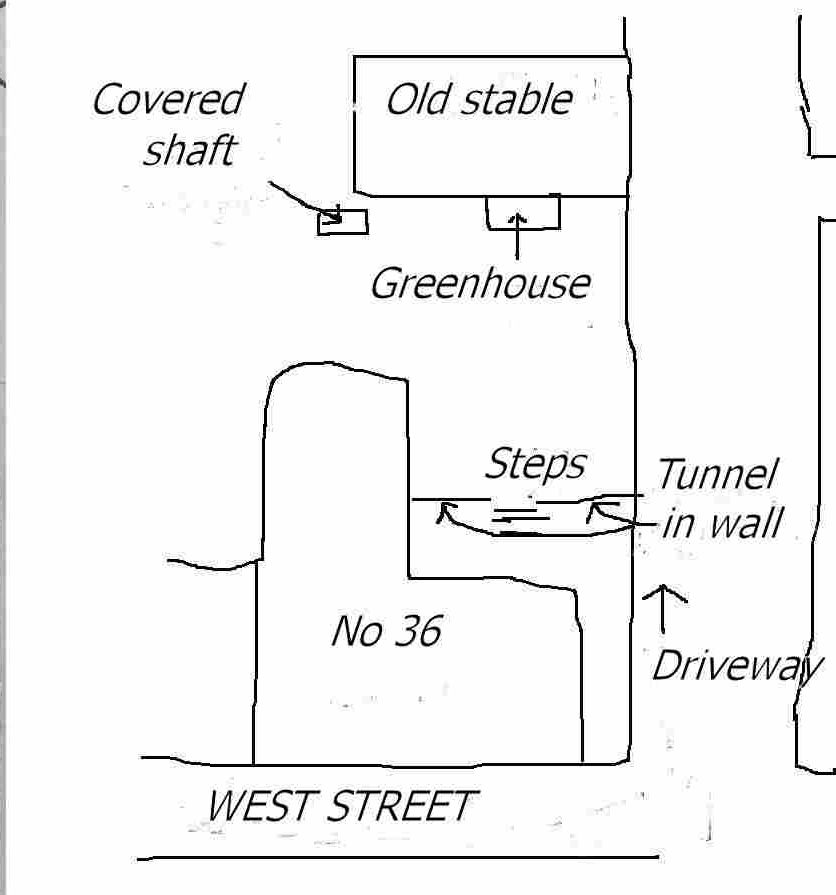
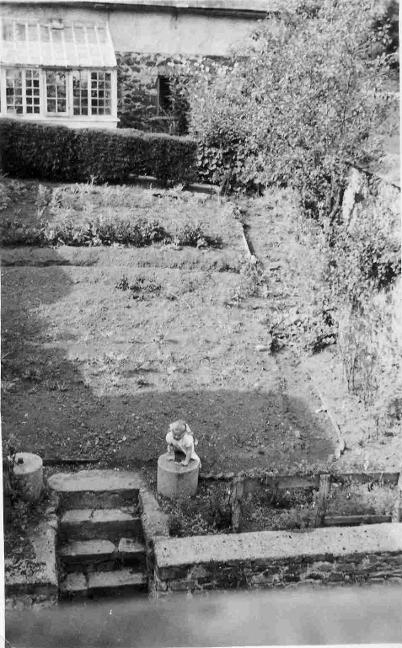
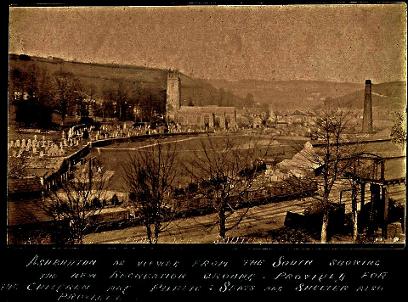
Accidents:
Thomas Squires, employed at the Devon
and Cornwall Umber works, suffered serious injury to his legs during a
collapse of earth. He was taken to the Cottage Hospital.
Western Times 9 December 1886 p2 col4
James Honywill suffered a severe injury to his foot when a large rock fell on it at the Devon and Cornwall Umber Company.
Western Times 4 May 1891 p2 col4
And misdemeanours:
Messrs
Hosking and Pascoe, of the Ashburton Umber Works Company, were fined £1
at Ashburton Petty Sessions for having an unstamped weighbridge.
Exeter and Plymouth Gazette 24 April 1894 p7 col5
********
White's Directory of Devon 1878-79 has the following entries for umber:
Roborough Umber Co., Nicholas Pascoe, Captain, Balland Cottage
Devon and Cornwall Umber Co., Jonathan Cock, Captain.
White's History, Gazetteer & Directory of Devon, 1878-79 pp 108,109
http://www.historicaldirectories.org
In the 1881 census 43 year old Jonathan Cock and his wife Jane were living at Dolbear. With them were four daughters and two sons, including 15 year old Jonathan jnr. All had been born at Roche in Cornwall apart from the three youngest girls, two of whom had been born at Veryan, and the very youngest, 9 year old Catherine, at Ashburton.
Jonathan was an umber mine agent; his sons were umber miners.
1881 census RG11, piece no. 2161, folio 18 p16
There are two entries for Umber Mines in the 1893 edition of Kelly's Directory of Devon and Cornwall:
Ashburton Umber Company, William Henry Hosking, Sec
Nicholas Pascoe, Captain
Devon and Cornwall Umber Mine (The Truro Colour Co.), Jonathan Cock, Agent
Kelly's Directory of Devon and Cornwall, Part 2, p1000
http://www.historicaldirectories.org
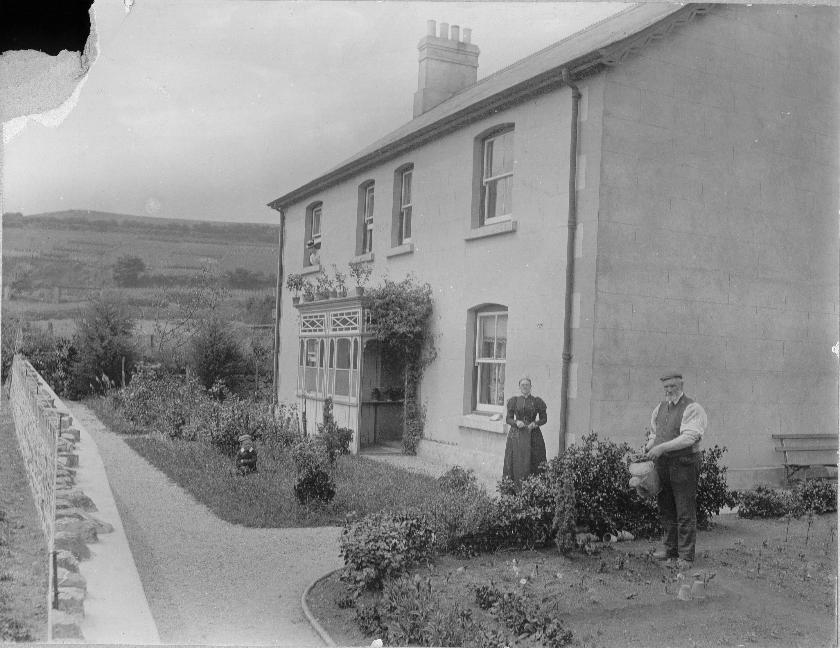
Nicholas
Pascoe died in March 1908. The Exeter and Plymouth Gazette described
him as having been the owner and manager of the Leny Water Umber Works.
Exeter and Plymouth Gazette 1 April 1908 p3 col3
Kelly's Directory of Devon and Cornwall 1910 has the following entry under Umber Proprietors:
Ashburton Umber Co., William Henry Hosking, Proprietor
20, Courtenay Park, Newton Abbot, and Ashburton
Kelly's Directory of Devon & Cornwall, 1914.Part 2. p1188
http://www.historicaldirectories.org
William H Hosking, the son of W H Hosking, died at his home, Umbria, in East Street, in 1914. Connected with the umber industry, he was, said the Western Times, formerly a manager of the Leny Water Timber Works*.
The flag at the Liberal Club hung at half mast until the funeral.
Western Times 13 February 1914 p14 col1
* The Exeter and Plymouth Gazette calls this the Leny Water Umber Works in 1908
When Mr Abraham gave land to build the new Cottage Hospital on, it was described as being near Leny Water
Western Times 11 April 1887 p4 col3
******
At one stage the Ashburton Color Co., Devon had freehold and leasehold Lands.
Undated documents ref X 116/44 are in the Cornwall Record Office
*******
Company No: 17395; Ashburton Silicate Oxide Paint Company Ltd. Incorporated in 1882. Dissolved before 1916
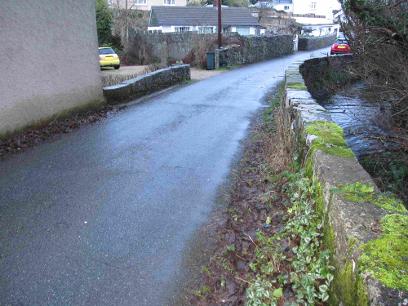
In May 1885 there was a fire at the Silicate Oxide Paint company's works. The timber and corrugated iron buildings, situated near Gulwell Bridge, were completely destroyed, together with many tons of paint. It was thought that the fire began in a drying kiln.
Western Times 12 May 1885 p3 col1
(To the ) 'East of Dartmoor roofing slates are obtained at Ashburton..'
White's History, Gazetteer & Directory of Devon, 1878-79 p63